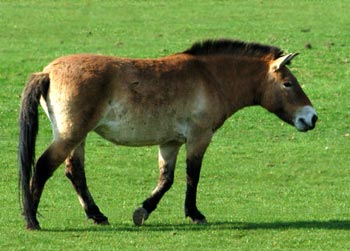
This region includes Europe, Russia up to pacific coast and Mediterranean up to Sahara. Climate is temperate and polar in the north. Eastern Asia is temperate with deciduous forests. In northern zone there are grasslands (steppe) and interior portion is arid.
Mammals. There are 33 families of land mammals. Animals of word-wide distribution which amounts to one-third of families are rabbits, mice dog family, shrews, squirrels and cat family.
Animals that are restricted to the Old World include hedge hog, porcupine, civets, giant panda (Ailuropoda), hyena and pigs.
Four families are shared with Nearctic: beavers, jumping mice, flying squirrels, mole (Talpa) and four shared with African region.
Endemic mammals: mole rat (Spalacidae) and Camel (Seleviniidae), dormice.
African elements are wild horses, the prezevalski’s horse is the only truly wild horse in the world.
Aves. There are 53 families of birds most of which are migratory. All birds have wide distribution and are shared with Nearctic, Oriental and African regions, e.g. pheasants, wrens, finches, warblers, sea birds, geese, birds of prey, cranes, terns, gulls etc.
Hedge sparrow is restricted to this region.
Reptiles. There is no endemic reptilian family. Lizard, Sinisaurus, and Alligartor sinensis are endemic in China. There are lizards, snakes, Typhlops and sand boa, Trionyx and emydine turtles.
Amphibia. There are common newts, crested newt (Triton), Spanish newt and alpine newt. The colourless Proteus is blind and lives in European caves. There are European salamanders, Salamandra salamandra and S. atra and a species of giant salamander (Megalobatrachus) in Japan and China that attains a length of over 5 feet. Anurans are represented by frogs, toads, tree frogs. Male of the midwife toad (Alytes obstetricans), which is found in France and Italy carried eggs wrapped around his hind legs. Amphibians show affinities with Nearctic Region.
Fishes. Fish fauna also shows affinities with Nearctic. There is no endemic fish and carp is the dominant family. There are carps, salmon, pikes, perches, eels and Petromyzon that migrates from sea to the rivers to breed and the ammocoete larva, commonly known as sand sleeper lives in mud for several years in European rivers. Few species of toothless sturgeons immigrate from sea to the rivers of Japan and Russia for laying eggs which are harvested to prepare a delicacy called caviar.
The fauna is a mixture of Old World tropics and New World temperate.
SUBREGIONS OF PALAEARCTIC
European. Northern and central Europe. Black sea. The fauna hedge hog, shrew, mole and myogale (a mammal).
Mediterranean. Southern Europe. Arabian, Asia Minor, Afghanistan, Baluchistan and parts of Russia. Fauna includes civets, hyena, hyrax.
Siberian. Northern Asia north of Himalaya having extreme climatic conditions. Fauna includes yak, musk deer, mole, freshwater seal (Phoca sibirica) found in Baikal lake.
Manchurian. Mongolia, Japan, Korea, Manchuria, Tibet and northern China. The fauna contains Tibetan langur (Rhinopithecus), giant panda (Ailuropus), Chinese water deer (Hydropotes), tufted deer (Elaphodus).